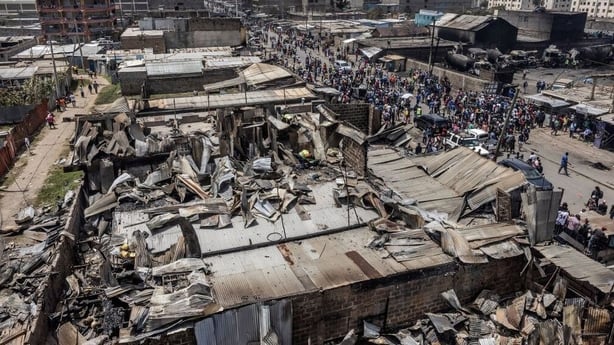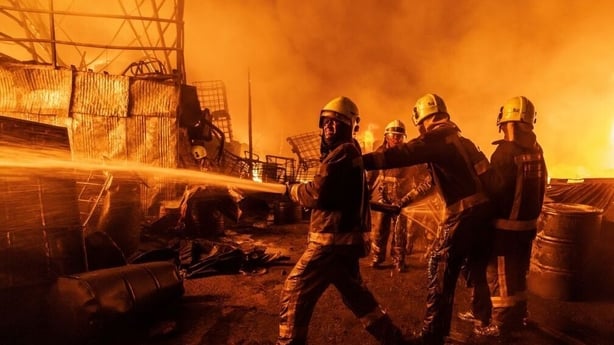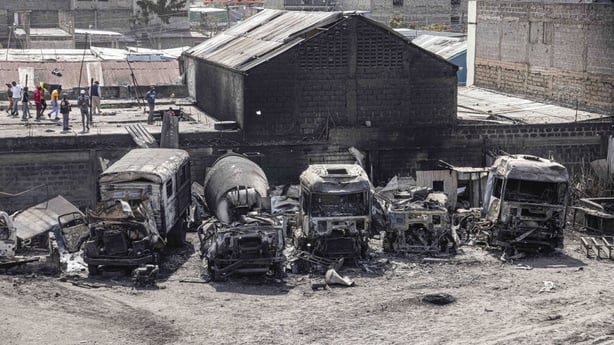A gas truck exploded in Kenya's capital Nairobi, sending a huge fireball into the night sky and causing a blaze that killed at least three people and injured 300, according to authorities and first responders.
Residents in a nearby building screamed as a column of flame shot hundreds of metres into the air just before midnight (3am Irish time), briefly forming a mushroom cloud, video posted on social media showed.
The government said three people had died in the explosion at a gas refilling plant and 280 more were in hospitals around Nairobi.
The Kenyan Red Cross said others were being treated at a triage point.
The fire engulfed a nearby textile and garment warehouse, while damaging several vehicles and commercial and residential properties, the government said.
Firefighters managed to bring the blaze under control by around 9am (6am Irish time), more than nine hours after it erupted in the Embakasi area of Nairobi.
Deputy Inspector of Police Douglas Kanja said a guard at the site where the explosion occurred had been arrested and that investigations were ongoing.
"The fire caught up with me from almost one kilometre away as I was escaping," survivor Edwin Machio said.
"The flames from the explosion knocked me down and burnt me on my neck," he added.
Beautician Vivian Njeri said she had just arrived home when the disaster struck, but managed to escape with injuries to her back and hands.
"We were running and screaming because there was fire all over outside," the 34-year-old said, speaking from a tent outside a Nairobi hospital where victims were being treated.

Residents said they had long feared such a disaster, with gas trucks arriving every day in the area.
Kenya's Energy and Petroleum Regulatory Authority (EPRA) said last year that it had rejected three applications for construction permits for a liquefied petroleum gas (LPG) storage and refilling plant at the site of the explosion because of the high population density around it.
EPRA said it had asked the applicant to submit a risk assessment "indicating the radiation blast profiles in the unfortunate case of an explosion" but that this was never done.
It was not immediately clear who owned the site.
Kenyan government spokesman Isaac Maigua Mwaura said the explosion ignited a "huge ball of fire that spread widely".
"Consequently, the inferno further damaged several vehicles and commercial properties, including many small and medium sized businesses.
"Sadly, residential houses in the neighbourhood also caught fire, with a good number of residents still inside as it was late at night," Mr Mwaura added.

Images broadcast by local media showed a huge fireball close to several homes in Embakasi, an area that is home to about one million people, according to 2019 census figures.
Felix Kirwa, a motorcycle taxi driver, said he had just returned home when he heard two blasts that caused his house to shake and shattered a window.
The father of three grabbed his youngest child - a four-year-old boy - and ran out of the house, losing track of his other children in the confusion.
"I didn't know where the two other children ran to until this morning when I located them, and they are safe," he said, nursing a bandaged broken leg.
"We were in the house and heard a huge explosion," James Ngoge, who lives across the street from where the fire broke out.
"The whole building was shaken by a huge tremor, it felt like it was going to collapse. At first, we didn't even know what was happening, it was like an earthquake.
"I have a business on the road that was completely destroyed."
Stella Mbithi, a roadside vegetable vendor, was serving customers when she saw the sky turn orange with flames.
"We all took off. It was chaotic because people were screaming all over and vehicles were honking horns. I fell down several times," she said. "I am lucky to be alive."

The explosion forced many of the area's residents to spend the night outside, with large columns of black smoke seen billowing from the area.
Some people could be seen collecting their belongings and surveying the damage to their homes.
"The scene has now been secured and a command centre is now in place to help coordinate rescue operations and other intervention efforts," Mr Mwaura said.
Similar disasters have occurred in Nairobi before.
In 2011, more than 100 people were killed in a slum in the Embakasi area when fuel spilled from a pipeline and burst into flames.
Many of the victims were burnt beyond recognition.
In 2018, a blaze at Nairobi's Gikomba market killed 15 people, including four children, and injured at least 70.

